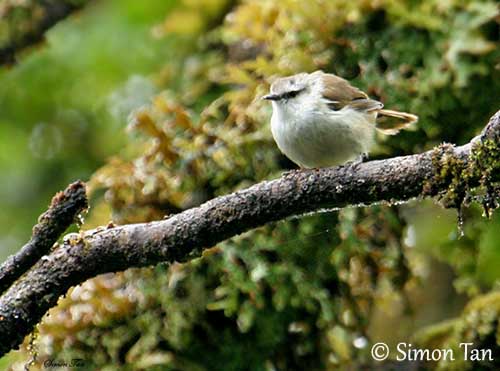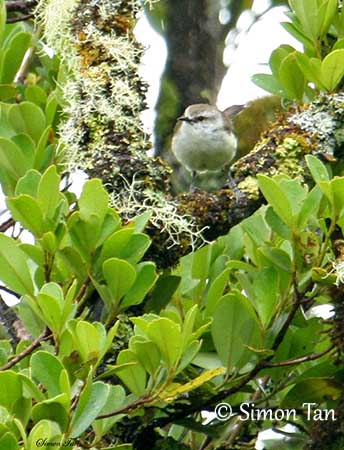
PROTECTION / THREATS / STATUS:
The Chatham Islands Gerygone is evaluated as Nationally Vulnerable in New Zealand. But this species is secure in several sanctuaries in southern Chatham Islands where predators and pests are controlled. It is also established on predator-free islands South of Pitt Strait.
The species is locally abundant and the population size ranges between 1000 and 5000 mature individuals. The species remains vulnerable to cats and rats, and reduction of the habitat, but currently, the Chatham Islands Gerygone is evaluated as Least Concern, although being decreasing.
Fr: Gérygone des Chatham
Ang: Chatham Islands Gerygone
All: Langschnabelgerygone
Esp: Gerigón de las Chatham
Ita: Gerigone dell'Isola Chatham
Nd: Chathammangrovezanger
Sd: Chathamgerygone
Photographer:
Simon Tan
PBase Bird galleries
Text by Nicole Bouglouan
Sources:
HANDBOOK OF THE BIRDS OF THE WORLD Vol 12 by Josep del Hoyo-Andrew Elliott-David Christie - Lynx Edicions - ISBN: 8496553423
BirdLife International (BirdLife International)
New Zealand bird status between 2008 and 2012
Te Ara – The Encyclopedia of New Zealand
Home page
Page Passeriformes Order
Chatham Islands Gerygone (Warbler)
Gerygone albofrontata
Passeriformes Order – Acanthizidae Family
INTRODUCTION:
The Chatham Islands Gerygone is endemic to the Chatham Islands, New Zealand. This small forest bird is larger than the Grey Gerygone (G. igata) from the mainland, and male and female have distinct plumages.
DESCRIPTION OF THE BIRD:
Biometrics:
Length: 12 cm
Weight: M: 10-11 g - F: 9 g
The adult male has olive-brown head and upperparts, including the upperwing. The tail is mostly grey-brown with blackish subterminal band. The rectrices show large white spots on the inner webs, except on the central pair.
On the white underparts, flanks and vent are pale yellowish to pale olive.
On the head, the male has conspicuous white forehead and supercilium. The throat is white too.
The relatively long bill is blackish with paler base of lower mandible. The eyes are dark red. Legs and feet are greyish-brown to dark grey.

The adult female is slightly smaller than the male. She has much reduced white on forehead, whereas eyebrow and underparts are duller, mostly greyer.
The juvenile resembles female but the eyebrow is less distinct. It has pale yellowish face and underparts. The eyes are dark brown (not red). The bill is brownish to fleshy-horn with paler pink base. Legs and feet are dull pink.
RANGE:
The Chatham Islands Gerygone is resident in the Chatham Islands and can be found mainly in the south-west. The species is common on Pitt Island, Little Mangere Island and Star keys.
HABITAT:
The Chatham Islands Gerygone frequents the dense native forest from the sea-level to the plateaux. It is also found in thickets and shrubland.
CALLS AND SONGS: SOUNDS BY XENO-CANTO
The Chatham Islands Gerygone is more often heard than seen. It utters a loud warbling call, and the initial phrase is repeated several times.
The territorial song by the male during the breeding season is a rapid phrase of 4-5 notes with descending pitch.
BEHAVIOUR IN THE WILD:
The Chatham Islands Gerygone feeds mainly on small invertebrates such as flies (Diptera), beetles (Coleoptera), moths and caterpillars (Lepidoptera) and also spiders (Araneae).
It forages by gleaning insects from vegetation, twigs and foliage. It also probes into the bark crevices in trunks and branches, or searches in the leaf-litter. It does not hover unlike the Grey Gerygone.
The Chatham Islands Gerygone feeds alone or in pairs, and often in small family groups. Outside the breeding season, it forms flocks, and often forages with the New Zealand Fantail (Rhipidura fuliginosa).
The feeding grounds include the understorey of the dense forest and the coastal shrubland, where it forages in dead wood and endemic plant species. Unlike other gerygones, it can spend much time on the ground.

The territorial male sings to advertise the territory, and other bird species are chased away from the nest-site and the area during the breeding season. The male engages in long chases interspersed with loud songs.
This species is sedentary in its range.
It performs short flights through the vegetation during the territorial disputes, but this species is not a strong flier.
REPRODUCTION OF THIS SPECIES:
The breeding season occurs from September to January, with the laying between September and December.
The nest is built by the female while the male defends the territory. This is a roughly pear-shaped structure hanging from a branch, with a lateral entrance towards the top and a vegetal protection above. It is made with grass stems and rootlets woven together. Other materials such as moss, fern or bark can be added and held with spider webs. A soft lining of feathers is added inside the nest.
The female lays 2-4 white eggs with brownish markings on the larger end. She incubates alone during 17-21 days, and broods the chicks during the first days of their life. Then, male and female feed them. The young fledge 19-23 days after hatching. They still depend on parents for food for up to 24 days, and the adults split the brood to feed the juveniles.
The nest of the Chatham Islands Gerygone is sometimes parasitized by the Shining Bronze Cuckoo during the second clutch.
